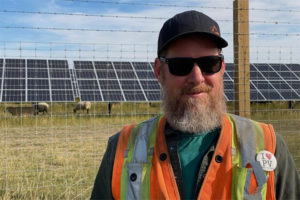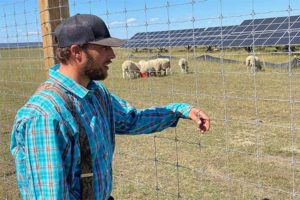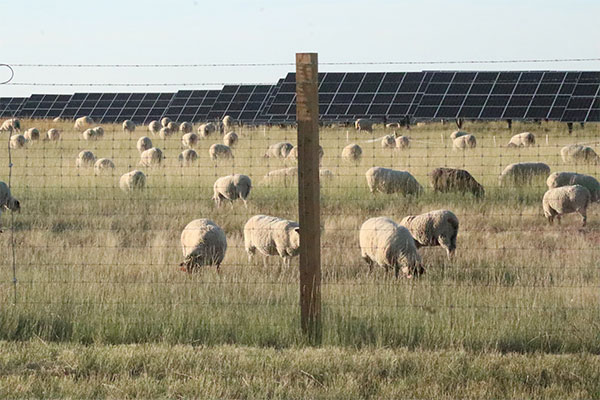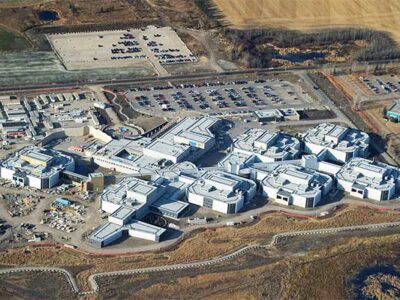- An unexpected symbiotic relationship has formed between solar companies and sheepherders across North America.
- Called "Solar Grazing," the service provides a necessary solution to solar companies since overgrowth can create patches of shade that render solar panels inefficient.
- Compared to other solutions, sheep grazing poses minimal risk to equipment while offering maximum rewards.
In an era marked by cheap, disposable, technological solutions to every problem, an answer to solar energy’s persistent issue of overgrown vegetation has emerged straight out of medieval farm sheep. These fluffy gardeners get all the grass they can eat and shelter from the hot sun while taking care of overgrowth on utility-scale solar installations.
This innovation comes at a critical moment for western Canada, which has the highest solar irradiance in the country and thus the greatest potential for solar energy production. Naturally, provinces like Alberta are seeing a boom in solar power production.
The Travers Solar Project will soon transform more than 3300 acres of land into 465 MW of clean renewable power generated by more than 1.3 million solar panels.
Sheep Already Making a Difference
The service sheep are a necessity to the industry, as weeds and overgrown grass create patches of shade which render solar panels inefficient when not controlled.

Gregory Lamming of Capstone Infrastructure at Claresholm Solar Farm. (Photo David Dodge, GreenEnergyFutures)
According to the Western Producer, a solar project near Strathmore, Alberta, will employ local ranchers to keep the solar farm weed-free for the next three years. Similarly, the Strathmore Solar project, run by Capital Power Corporation, signed a deal with Whispering Cedars ranch for their flocks to tend the grass beneath a solar farm that provides more than 40 MW to the local grid.
Other Methods of Controlling Vegetation don’t Compete with Solar Grazing
Other methods of controlling vegetation include herbicides, gas and electric lawn mowers, or even other grazing animals like cows and goats. However, each of these methods suffers from drawbacks not affecting sheep.
Herbicides are expensive and environmentally destructive, which is bad for clean energy producers. Lawnmowers are difficult to maneuver beneath the panels and pose a damage risk to sensitive equipment.

Glen Walter of the Granum Hutterite Colony at Claresholm Solar Farm tending 1,300 head of sheep. (Photo David Dodge, GreenEnergyFutures)
Cattle are generally too large, unless the panels are significantly elevated. Also, cattle tend to rub against nearby structures to scratch an itch, which could damage panels. Goats, while appropriately sized, chew on wires as readily as grass and are avid climbers, neither quality being conducive to efficient solar farming. Whereas sheep lack these qualities and bad habits, making them a perfect fit for solar farms.
What do Sheep and Shepherds Get Out of the Deal?
Aside from a free lunch, the primary benefits to sheep are shade and land to graze. The land is expensive, particularly near cities, limiting a ranch’s ability to expand. By using the land allotted to solar farming, sheep ranchers have room to expand their flocks while making a profit.
This is particularly important as the capital regions of Alberta, Saskatchewan, and Manitoba happen to sit in the highest irradiance bubble in Canada, with an average PV potential of between 1200 and 1400 kWh/kWp, according to Natural Resources Canada. Meanwhile, the sheep benefit from the significant shade provided by large-scale solar farms. During intense heat waves like the heat dome of last year, the shaded areas tend to have more fertile undergrowth for flocks to dine on, while also keeping the animals at a reasonable temperature away from the glaring sunlight.
Added Benefits
In a harmonious natural cycle, sheep manure helps fertilize the grass beneath the modules, improving future growth. With a flock of 1200 sheep, the Claresholm Solar Project, producing 132 MW for 33, 000 Alberta homes, was able to mow approximately 300-400 acres per month with an arrangement of pens the herd rotates through.
Since mutton is still an uncommon menu item, this is a market sheepherders can exploit while helping protect solar panels from the drawbacks of riskier overgrowth management solutions.













Comments